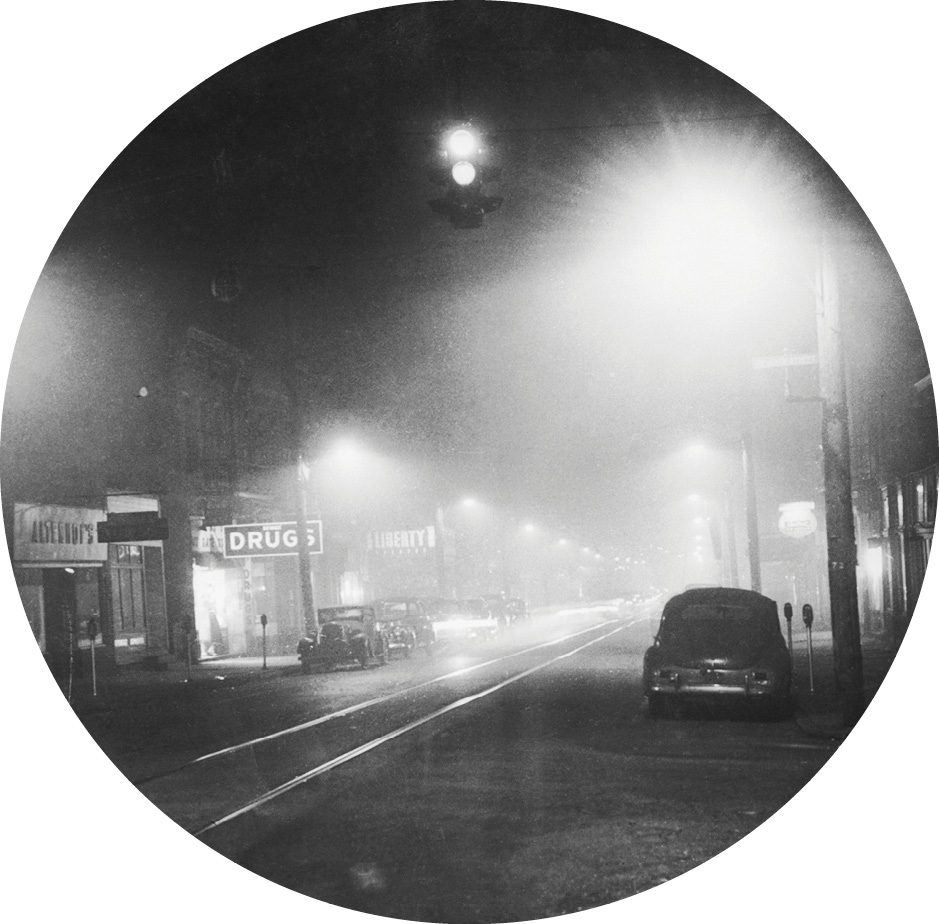Oct. 26-31, 1948: A deadly fog kills 20 in a Pennsylvania company town

Donora, Pennsylvania in late October 1948. (Photo by Bettman)
From the time it was founded, Donora was a Pennsylvania company town. Its developers, industrialist/banker Andrew Mellon and his protege, William Donner, designed it that way.
In spring 1900, ads appeared in Pittsburgh-area newspapers announcing the imminent availability of “very handsome residences” juxtaposed to “the largest and most complete wire rod and nail works in the world.”
Sponsored by Mellon’s Union Steel, the ads assured potential workers and their families: “The town will be modern in every respect, paved, sewered, and in fact, everything done to make it a healthful and desirable place to live.” By the end of the first day of sales that August, eager buyers had laid down $225,000 for future homesteads.
Houses went up quickly, along with a brick school building, several hotels, a park and a Mellon-owned bank. So too did the promised factories: The wire rod mill was followed by nail, blooming and fence-binding mills, followed by steel bar and slab forgeries—all supported by blast furnaces, coke ovens, Bessemer converters and, in 1915, a zinc works and acid plant.
But the promise of a healthful place to live proved more problematic. Along with the proliferation of factory jobs came smokestacks, slag piles and, over time, a sulfuric smell and sooty texture to the air in and around Donora.
On May 30, 1930, George Gliwa, a farmer in nearby Lincoln, filed a lawsuit against U.S. Steel, which by then owned most of the forging operations in the region. Gliwa alleged that sulfuric acid from a nearby coke oven was poisoning his cattle, his cabbage crops and his ailing wife. The suit gained momentum—and a few new plaintiffs—with news in December that 60 had died suddenly when Belgium’s Meuse Valley was beset by a stubborn sulfuric fog. Gliwa’s suit was dismissed after a 10-year legal battle, but his concerns were reiterated when Donora faced a fatal fog of its own.
Few of the town’s 13,000 residents took notice when on Tuesday, Oct. 26, 1948, a peculiarly dirty mist settled over Donora. “Smog”—a term coined in 1905 in London—was a fact of industrial life. And in Donora, seated low in the Monongahela River Valley, heavy smog sometimes required streetlamps at midday.
But this fog, stalled by a stubborn cold front, grew viscous and increasingly toxic as the week wore on. Women fainted at home. Factory workers panted during short walks. Children rubbed blackened mucus from their noses. Doctors, scrambling hectically between house calls and hospital beds, were themselves sickened at the end of each day. On Saturday morning, the sick began dying. By midnight, 17 were dead.
The factories, having churned obliviously all week, shut down only after famed broadcaster Walter Winchell embarrassed them on his weekly radio show. Though a Sunday afternoon rainfall finally cleared a quiet Donoran skyline, thousands remained sickened and by day’s end, three more were dead.
On Nov. 30, when public health officials finally arrived in Donora, they arrived in force. A team of 25 investigators from the U.S. Public Health Service spent five months studying the factory town and the health of its inhabitants, surveying virtually every facet of industrial life suspected of contributing to the disaster.
In its final report, the team conservatively estimated that during the six days of smog, the zinc works alone had belched more than 1 million pounds of zinc, sulfur dioxide, nitrogen oxides, carbon dioxide and other particulates into Donora’s stagnant skies. They estimated that the pollution had compromised the health of more than 40% of the town’s population, particularly the elderly.
Though the need for operational reforms at the factories were acknowledged on all sides, the report fell short of blaming them for the disaster, suggesting that coal-fired furnaces in homes, automobile exhaust and unusual weather conditions contributed to the 20 deaths assigned directly to the smog. As a result, U.S. Steel settled 130 lawsuits related to the incident for a total of $235,000.
Over the next several decades, the public health issues raised by the Donora incident proved pivotal in the advent of the environmental movement and environmental law.
This story was originally published in the October/November 2024 issue of the ABA Journal under the headline: “A Deadly Fog Kills 20 in Donora.”



